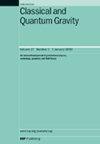New agegraphic dark energy driven reconstruction of f(Q) gravity and its cosmological implications
IF 3.7
3区 物理与天体物理
Q2 ASTRONOMY & ASTROPHYSICS
引用次数: 0
Abstract
In this work, we perform reconstruction of f(Q) gravity inspired by the new agegraphic dark energy (NADE) model, aiming to account for the Universe’s late-time acceleration without invoking a cosmological constant. Utilizing a power law scale factor , we derive an analytic form for f(Q) based on a correspondence with NADE, where the conformal time serves as the infrared cutoff. The resulting model naturally recovers general relativity in the limit and exhibits a geometrically motivated dark energy component. We constrain the model parameters using recent Baryon acoustic oscillation (BAO) data from DESI DR2 BAO and previous BAO observations through the Markov Chain Monte Carlo analysis. The reconstructed Hubble parameter H(z) demonstrates excellent agreement with observational data, achieving high R2 values and low , AIC, and BIC scores, outperforming the standard ΛCDM model. Further, we investigate the cosmological evolution using the deceleration parameter q(z), effective equation of state , and Om diagnostics. The model exhibits a clear transition from deceleration to acceleration with a present value and transition redshift , while maintaining , indicating quintessence like behavior. Om diagnostics consistently show a negative slope, further confirming deviation from ΛCDM. Energy condition analysis reveals that WEC, DEC, and NEC are satisfied, while SEC is violated only at low redshifts, which is consistent with cosmic acceleration. Also, stability analysis for the model shows stable behavior under scalar perturbations. Overall, the reconstructed f(Q) model provides a viable, stable, observationally consistent, and theoretically motivated alternative to standard dark energy scenarios.新年龄暗能量驱动的f(Q)引力重建及其宇宙学意义
在这项工作中,我们在新的年龄暗能量(NADE)模型的启发下进行了f(Q)引力的重建,旨在解释宇宙的晚时间加速而不调用宇宙常数。利用幂律比例因子,我们基于与NADE的对应推导出f(Q)的解析形式,其中保形时间作为红外截止时间。由此产生的模型自然地恢复了广义相对论的极限,并显示出几何激发的暗能量成分。我们利用DESI DR2 BAO最近的重子声学振荡(BAO)数据和以前通过马尔可夫链蒙特卡罗分析的BAO观测数据来约束模型参数。重建的哈勃参数H(z)与观测数据非常吻合,R2值较高,AIC和BIC分数较低,优于标准ΛCDM模型。进一步,我们利用减速参数q(z)、有效状态方程和Om诊断来研究宇宙演化。该模型表现出从减速到加速的明显转变,具有现值和过渡红移,同时保持,表明了典型的行为。Om诊断一致显示负斜率,进一步确认偏离ΛCDM。能量条件分析表明,WEC、DEC和NEC满足,而SEC仅在低红移时被违反,这与宇宙加速一致。模型的稳定性分析表明,该模型在标量扰动下具有稳定的行为。总的来说,重建的f(Q)模型提供了一个可行的、稳定的、观测上一致的、理论上有动力的替代标准暗能量情景。
本文章由计算机程序翻译,如有差异,请以英文原文为准。
求助全文
约1分钟内获得全文
求助全文
来源期刊

Classical and Quantum Gravity
物理-天文与天体物理
CiteScore
7.00
自引率
8.60%
发文量
301
审稿时长
2-4 weeks
期刊介绍:
Classical and Quantum Gravity is an established journal for physicists, mathematicians and cosmologists in the fields of gravitation and the theory of spacetime. The journal is now the acknowledged world leader in classical relativity and all areas of quantum gravity.
 求助内容:
求助内容: 应助结果提醒方式:
应助结果提醒方式:


